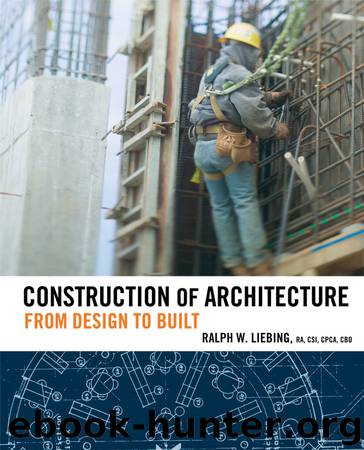Construction of Architecture by Ralph W. Liebing

Author:Ralph W. Liebing
Language: eng
Format: epub
Publisher: Wiley
Published: 2011-08-18T16:00:00+00:00
Code Compliance Review And Permitting
The construction industry as a whole and its work are highly regulated. This involves, where the work is concerned, the enacting of laws (building and other codes) and other regulations with regard to fire resistance, life safety, structural capacity, adverse conditions (seismic, climatic, weather events, etc.). In the United States, there are some 19,000 jurisdictions (states, counties, cities, villages, etc.) that enforce building codes; most are adaptations of one of the three current model codes available. The agencies who wrote these codes (Building Officials and Code Administrators [BOCA], Southern Building Code Congress International [SBCCI], and the International Conference of Building Officials [ICBO]) combined their efforts and produced the International Building Code (IBC) and associated other codes, for publication and enactment starting in 2000. Each of these model code groups had their codes adopted for use in several other countries, but it is still unclear what pattern of use and adoption worldwide will be forthcoming in response to this new array of codes. Ideally, there will be wide adoption worldwide, which will provide uniform control of construction from area to area.
As an aside, it should be noted that the construction industry, because of its inherent safety exposure, is regulated by the U.S. Occupational Safety and Health Administration (OSHA), as well as by state workers’ compensation provisions, industrial relationship rules, and other occupational and workplace constraints. All of these, however, are aimed at the workers and their welfare, and not at the project work itself.
Quite often, the completed contract documents are submitted to the regulatory agencies for their review (of the methods used to comply with the regulations) and issuance of required permits. The filing of the application may be done prior to the bidding period, since changes that are required can then be incorporated into the project via the issuance of addenda. Good practice would note that there should be an ongoing rapport with the regulatory agencies, to ensure that the project progresses in accord with the various requirements. It is not prudent to make a code search early in programming, and then never approach the agencies again until time for permits. There are almost always items of design and work that require some interpretation of the laws, and best effort would call for resolution of these situations so they can be correctly incorporated into the final documents. Additionally, regulations are changed periodically, and there may be new provisions that apply to the project; these may aid or inhibit the project as designed.
This application sequence is critical so the time required for review of the documents does not slow or inhibit project progress. This is even truer when there is a need for an appeal or variance from the regulations, to meet the specific circumstances of the project. These procedures should be initiated as soon as it appears they are needed, since they can be time-consuming and could delay the anticipated start of work. Hence, the design professional often will file the permit application(s) and will field any questions coming back from the agencies.
Download
This site does not store any files on its server. We only index and link to content provided by other sites. Please contact the content providers to delete copyright contents if any and email us, we'll remove relevant links or contents immediately.
| American National Standards Institute (ANSI) Publications | Architecture |
| History | Measurements |
| Patents & Inventions | Research |
Whiskies Galore by Ian Buxton(41939)
Introduction to Aircraft Design (Cambridge Aerospace Series) by John P. Fielding(33093)
Small Unmanned Fixed-wing Aircraft Design by Andrew J. Keane Andras Sobester James P. Scanlan & András Sóbester & James P. Scanlan(32764)
Craft Beer for the Homebrewer by Michael Agnew(18197)
Turbulence by E. J. Noyes(7978)
The Complete Stick Figure Physics Tutorials by Allen Sarah(7338)
Kaplan MCAT General Chemistry Review by Kaplan(6900)
The Thirst by Nesbo Jo(6881)
Bad Blood by John Carreyrou(6583)
Modelling of Convective Heat and Mass Transfer in Rotating Flows by Igor V. Shevchuk(6406)
Learning SQL by Alan Beaulieu(6237)
Weapons of Math Destruction by Cathy O'Neil(6216)
Man-made Catastrophes and Risk Information Concealment by Dmitry Chernov & Didier Sornette(5956)
Digital Minimalism by Cal Newport;(5704)
Life 3.0: Being Human in the Age of Artificial Intelligence by Tegmark Max(5516)
iGen by Jean M. Twenge(5385)
Secrets of Antigravity Propulsion: Tesla, UFOs, and Classified Aerospace Technology by Ph.D. Paul A. Laviolette(5333)
Design of Trajectory Optimization Approach for Space Maneuver Vehicle Skip Entry Problems by Runqi Chai & Al Savvaris & Antonios Tsourdos & Senchun Chai(5037)
Pale Blue Dot by Carl Sagan(4954)
